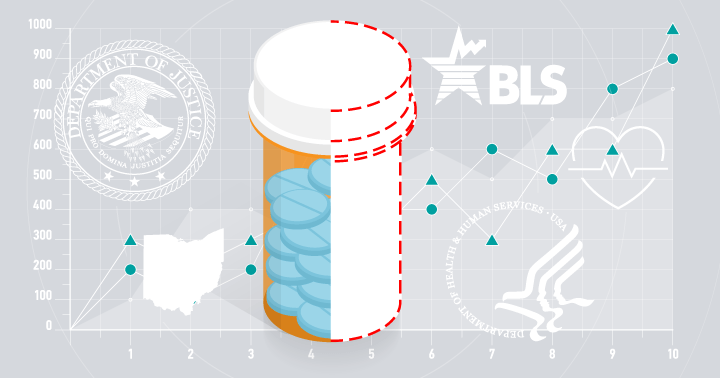5 sobering statistics related to drug diversion: What does it mean for Healthcare privacy and security?

Drug diversion in healthcare can pose major health and safety concerns for patients and care workers alike. Health Systems are faced with the challenge of tackling drug diversion in healthcare to help ensure patient safety and assimilate help for addicted care workers. There are steps health systems can take steps to implement a full-lifecycle drug diversion monitoring program that drives diversion out of their facilities and creates a culture of privacy, security, and compliance.
But first, you should know five sobering facts related to the opioid epidemic and drug diversion in healthcare — and the importance of addressing drug diversion in your facility to help improve patient safety and trust.
Drug Diversion Fact #1: More Than 42,000 People Died From an Opioid Overdose in 2017
Drug diversion is largely driven by opioid use disorder, which is the clinical term for opioid addiction or abuse. In 2017, 42,249 people died from an opioid overdose — 40 percent of which involved prescription opioids. Why the massive increase in addiction and overdose deaths? Many researchers believe that overdose deaths are linked to the availability of these addictive drugs. Between 1999 and 2011, hydrocodone consumption increased by 100 percent, while consumption of oxycodone increased by about 500 percent. Internationally, hydrocodone was prescribed 136.7 million times in 2011, and oral opioids in general 238 million times.
Drug Diversion Fact #2: The DOJ Has Made 50+ Enforcement and 280+ Administrative Actions Related to Drug Diversion in 2018
The Department of Justice (DOJ) and the U.S. Drug Enforcement Administration (DEA) are pouring vast resources into tackling the growing problem of drug diversion, with 54 enforcement actions and 283 administrative actions taken in 2018. Why? Quite simply, drug diversion affects patient care, even if diverters are stealing a small amount of drugs. This patient impact has pushed drug diversion to the forefront of these agencies’ priorities in 2018. Efforts incorporate drug diversion investigators, intelligence research specialists, and special agent.
Drug Diversion Fact #3: The HHS Invested Almost $900 Million in Opioid-Specific Funding in 2017
The U.S. Department of Health and Human Services declared the opioid crisis a public health emergency in 2017, and invested almost $900 million in opioid-specific funding that year alone — including funds for states, local governments, and civil society groups. In addition, the agency released a five point-plan around opioid strategy:
- Better addiction, prevention, treatment, and recovery services
- Better data
- Better pain management
- Better targeting of overdose-reversing drugs
- Better research
The goal of course is to improve patient care and get addicted care workers the treatment they need to recover.
Drug Diversion Fact #4: 94% of the Top-Abused Prescriptions Are Schedule II, III, or IV Medications (e.g., Ritalin, Oxycodone, Ativan, Vicodin, Percocet)
Controlled substances have the highest potential for drug diversion. These are regulated by the DEA under the Controlled Substances Act based on their intended medical use, as well as their potential for dependence and abuse. High-value controlled substances that are commonly diverted include scheduled drugs as listed by the DEA:
- Schedule I: heroin, lysergic acid diethylamide (LSD), marijuana (cannabis), methaqualone, and 3,4-methylenedioxymethamphetamine (“Ecstasy”).
- Schedule II: hydromorphone (Dilaudid®), methadone (Dolophine®), meperidine (Demerol®), oxycodone (OxyContin®, Percocet®), and fentanyl (Sublimaze®, Duragesic®). Other Schedule II narcotics include: morphine, opium, codeine, and hydrocodone.
- Schedule III: products containing not more than 90 milligrams of codeine per dosage unit (Tylenol with Codeine®), and buprenorphine (Suboxone®).
- Schedule IV: alprazolam (Xanax®), carisoprodol (Soma®), clonazepam (Klonopin®), clorazepate (Tranxene®), diazepam (Valium®), lorazepam (Ativan®), midazolam (Versed®), temazepam (Restoril®), and triazolam (Halcion®).
- Schedule V: cough preparations containing not more than 200 milligrams of codeine per 100 milliliters or per 100 grams (Robitussin AC®, Phenergan with Codeine®), and ezogabine
According to the U.S. Bureau of Labor Statistics, of the top-17 abused prescription, 94 percent were classified as Schedule II, III, or IV, including Ritalin, oxycodone, Ativan, Vicodin, and Percocet.
Drug Diversion Fact #5: There are 37,000 Drug Diverters Each Year
According to government-obtained data, the U.S. Department of Veterans Affairs (VA) reported that drug diversion incidents at 1,200 VA facilities jumped from 272 in 2009 to 2,926 in 2015. John Burke, president of the International Health Facility Diversion Association, has extrapolated data from facilities in Ohio, and estimates that, at any given time, there are 37,000 drug diverters each year nation-wide. Effects to patient care include denial of pain relief, blood-borne pathogens, identity theft, fraud, and patient harm.
These statistics represent the seriousness and scope of the issue of drug diversion in healthcare. Addressing the issue means crafting a drug diversion monitoring program so that you can drive harmful diversion out of your facility and help protect patients and care workers from the dangers and effects of addiction. Many care providers have a difficult time knowing where to start, and what to do once they catch instances of drug diversion in their facility.
